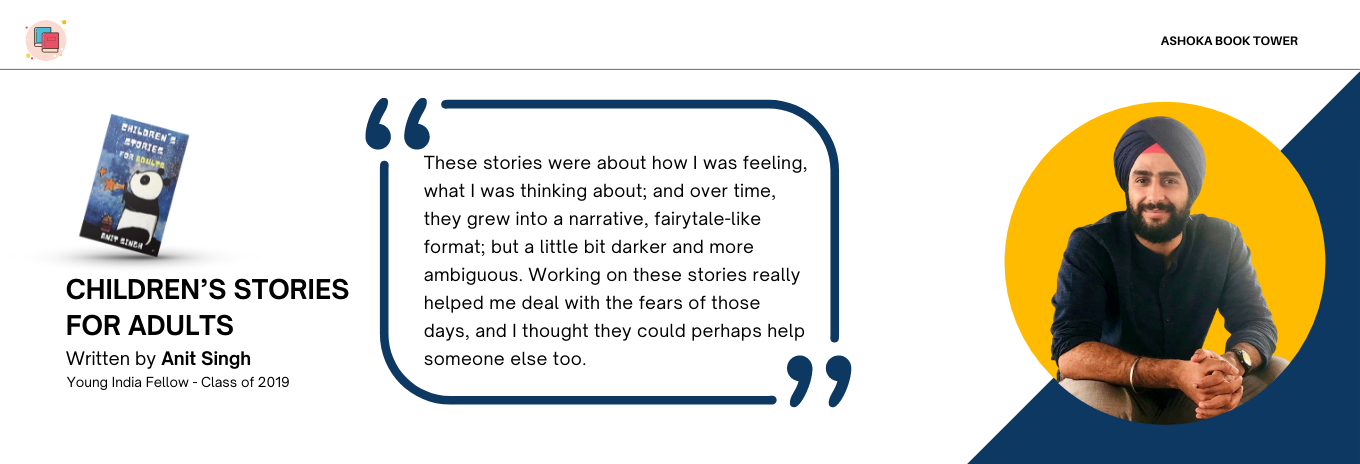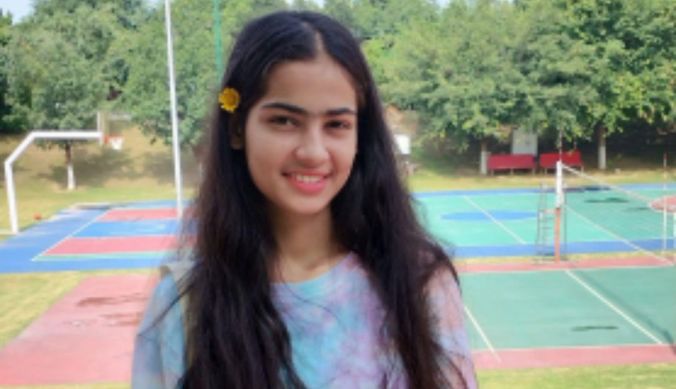#AshokaBookTower – ‘Children’s Stories for Adults’ – Written by Anit Singh, the book addresses complex questions through light-hearted fairytales
Published in June 2021, the book is a collection of fairytales which skillfully tackle tough issues of adulthood and leave the reader feeling comforted

Office of PR & Communications
4 October, 2021 | 4m readSynopsis:
“Children’s Story for Adults” is a collection of 10 lyrical short stories. Each story is set in a landscape of a dark emotion and the characters personify the ego as it tries to navigate the terrain. Partly narrative therapy and partly a foray into magical realism, the book contains a concoction of tales that break the barriers of subconscious, with its dreamlike weave and mythical quality. In Butterfly Songs, a mischievous boy is changed when he witnesses the death of his friend and then tries to turn back clocks in a hope that time would also turn back. In Sweet Grapes, a reformed hunter tries to outwit a deadly tiger with the help of grapes. Well, Frog plays upon repetitions and patterns to look at a frog who’s stuck at the bottom of a well and very happy, at least initially. The stories, like in every good fairytale, help the mind create a narrative that it can make sense out of and therefore go gently into a slumber, like that of a contented child.
In conversation with the author, Anit Singh, Young India Fellow 2018-19 alumnus, Ashoka University.
What inspired you to write this book?
I started working on these stories when the corona wave was just hitting India. Things were growing unpredictable, my partner was going through a transition in her job, and no one knew what would happen next. Eventually, she and I started discussing these questions. But, instead of approaching topics with no clear answers; I started telling her stories. These stories were about how I was feeling, what I was thinking about; and over time, they grew into a narrative, fairytale-like format; but a little bit darker and more ambiguous. Working on these stories really helped me deal with the fears of those days, and I thought they could perhaps help someone else too.
Children’s Stories for Adults is a fascinating title. Your comment.
When I was a kid, there was a gang of robbers that used to visit villages in the parts surrounding me. I often used to be terrified that they would come there and hurt someone. Then, my grandparents used to tell me traditional children’s stories; heroic tales where the hero wards off the robbers. They always used to calm me down. While working on this book, I realised that I am following a similar writing process. But I also realised that once we grow up, we do not really have these kinds of stories. We have fantastic books which deal with knotted social terrains, novels about famous people and their experiences; but not many collections of stories for adults which deal with complex issues while also bringing them solace.
Was there any particular reason for choosing the animal world as the primary setting?
I think because I can relate and relay my emotions more easily through animals. When you are crafting a story around a person, you need to flesh out the character, give it a voice, etc.; and then the primary story becomes about that character itself. With these stories, I wanted the feelings of the events to be more important than the actions of the characters. For instance, there is a story about a frog in which the character itself is transitory–there is no one frog in the story, and that is the entire point! The frog keeps on dying and then there is always another frog which takes its place. I like that. What is important here is not the frogs but the feelings which they rouse in you. Plus, I think we, humans, are very intimately connected with animals, and different animals generate different kinds of emotions in people like bats rouse disgust, lions rouse courage or fear, etc. That is a very broad and interesting spectrum to play around with and use to capture emotions.
Your stories are personifying animals and objects. Could you elaborate this choice?
I think this was not a conscious choice on my part but, everything that I wanted to communicate through these animals and objects required a certain level of personification and while writing it just became a natural part of the process. Plus, I was heavily influenced by books like Animal Farm and other writers who have done this before me.
Any particular writers and stories that you were inspired by while working on this book.
When I initially discovered him during my school years, I was completely in love with George Orwell’s work. I have admired Gabriel Garcia Marquez’s work for the longest too. Jonathan Swift has also been a favourite fixture since childhood. Recently, I have been reading a lot of Arundhati Roy and Kazou Ishiguro. And I think, through certain kinds of amalgamations of these writers and their influences I have also discovered my own voice. I am not sure if it is A + B + C or A + B + C into my own X that has finally come together to create a unique style of my own; but yes, all these writers are certainly a part of it.
Any insights you would like to share about the process of working on this book.
What I have learnt is that there is a space where the characters dwell alone, and there they keep on evolving themselves. Sometimes now, instead of consciously working on the stories, I just leave them; and when I come back I realise that the characters have already moved on and written their own stories; all that is left for me to do is to scribe them. That has worked really well for me. Instead of trying to force the story or certain plot points, I am giving it space and time and allowing it to go wherever it wants to go.
Tell us about yourself. What have you been upto after the Fellowship other than writing?
Currently, I am working as an L&D partner at Dr. Reddy’s. And it is a curious thing; because while I am in this space of learning and development, I often get the opportunity to ask people questions about which things are going right for them and which are not–and there are innumerable stories cloaked in their answers. I really enjoy that. Instead of going out of my way to find inspiration for characters, I have all these sources right in front of me.
Would you talk about how the whole YIF experience impacted your writing?
The YIF program provided me with a necessary pause. Just imagine: You’re in Sonepat, surrounded by acres upon acres of green farms–after some time, it almost feels like an island in itself. This distance and time away from the hubbub of my regular life allowed me to explore different philosophies and ideologies and think about them. Plus, there are so many different people on campus with their own stories and ways of looking at life. It is exciting to explore all these curious perspectives.
I think a lot of these experiences influenced my writing and provided me with fodder for my characters and arcs. There was also an element of YIF which acted as the catalyst for my writing–because before YIF while I was still thinking about these stories; I was never writing them down. All the critical thinking and writing courses during my Fellowship really aided that process. They also made me realise that I express and think best through putting pen to paper; and that was a pretty significant realisation for me.
What would you like your readers to take away from this book?
I would love it if they crafted their own stories. I believe that each one of us goes through a different experience in life; and our minds are great at narrativising those incidents. We all think: I grew up like this, there I was a hero, in that moment I was the villian, this was a failure, but that was an adventure, etc. The only requirement left is, perhaps, to create a few animals, sprinkle some sparkles and glitter, and voilà! we have a story. I would be very happy if this book inspires them to write their own tales.
Would you like to talk about your current and future projects?
Right now, I am putting together a book in which all the stories would be about different islands. It would be set in a space of magical realism–something would be happening that would be extremely common for the habitants of that island, but extraordinary for the readers. So, for example: there is one island in which it is very normal that people’s thoughts are heard out loud by everyone. For them, there is no concept of having private thoughts. And then, one day, there is a person who finds a room in which people cannot hear his thoughts. What happens then? In this way, I am creating different islands; each with its own set of rules. I think I will probably just call it “Wonderful Tour of Anit’s Islands” or something.
Anything else you would like to share.
I often think about the way most writers snatch away hours from their daily lives to write. You have a full schedule; and so you might wake up early or sleep late and steal that time to put down a few more words, and then come back to it later. Now-a-days, I wonder if this is perhaps a better process of writing than being a full-time writer; where there is a lot of pressure to write a certain number of words each day and to advance the plot…And as I said earlier, the story always takes its own sweet time. I am not really sure. But, I do think that this is a viable work-model for me to work on my stories in the coming times.
About Anit Singh:
Three generations of Anit’s family were constant migrants, scuttling across India on postings of their hereditary occupation- the army. As a result, the family became a reservoir of stories that were picked from all across the country and passed as a heritage to Anit. It was obvious that Anit would pick up a pen and craft the stories, floating in his blood. When he’s not reading or writing stories, Anit works as an HR in Dr. Reddy’s.
About #AshokaBookTower
The newly launched #AshokaBookTower campaign will showcase books written by our faculty, staff members, and alumni. The campaign aims to highlight the rich variety of subjects and intensive scholarship these books represent. An in-depth conversation with the author will also give a glimpse into what went into the writing of the book. This will be a recurring affair and will highlight some of the newest launches as well as the old collection.
Do follow us on social media (Facebook | LinkedIn | Twitter | Instagram) to know more about the campaign!













